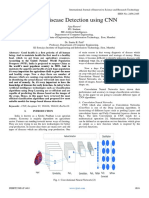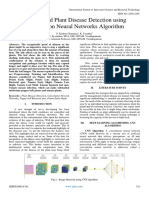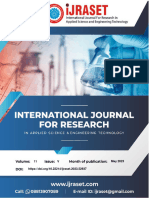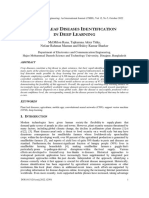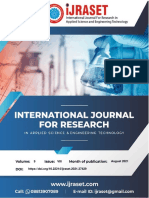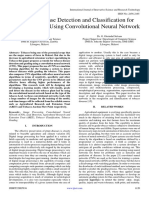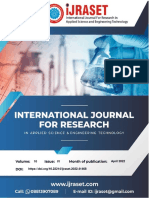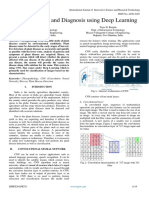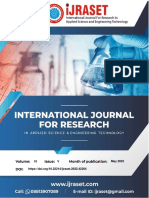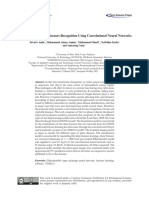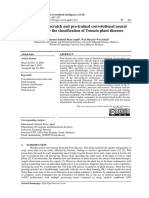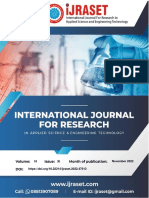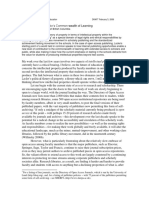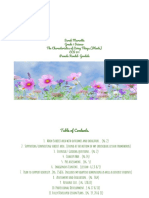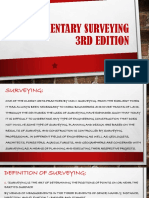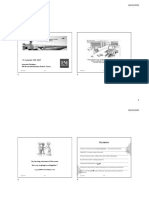Professional Documents
Culture Documents
Convolutional Neural Networks For The Detection of Multiclass Plant Diseases
Original Title
Copyright
Available Formats
Share this document
Did you find this document useful?
Is this content inappropriate?
Report this DocumentCopyright:
Available Formats
Convolutional Neural Networks For The Detection of Multiclass Plant Diseases
Copyright:
Available Formats
Volume 7, Issue 5, May – 2022 International Journal of Innovative Science and Research Technology
ISSN No:-2456-2165
Convolutional Neural Networks for the Detection of
Multiclass Plant Diseases
Dona Joby, Christeena Shaju, Fasna T A., Avani Das
Department of Computer Science and Engineering
Sahrdaya College of Engineering and Technology
Abstract:- Most industrialised countries' economies are proposed a number of strategies to address the issues
based on agriculture. Crop production is one of the most mentioned above. For the categorization of plant diseases,
influential factors in a country's domestic market many types of feature sets may be employed in machine
scenario. Agricultural output is also a crucial component learning. Traditional methods and deep-learning-based
of every country's economic development. Agriculture is characteristics are the most seen features among them. The
critical because it offers raw materials, work, and food to most promising way for automatically learning decisive and
a diverse population. Overuse of chemical fertilisers, discriminative characteristics is to use deep-learning-based
pollution of water supplies with chemicals, irregular algorithms, specifically CNNs. Deep learning (DL) is made
rainfall patterns, shifting soil fertility, and other factors up of several convolutional layers that reflect data learning
are among them. Apart from these challenges, disease- characteristics. Using a deep-learning algorithm, plant
related loss of a significant section of output is one of the diseases may be detected. Deep learning has certain
most prominent roadblocks across the world. The disadvantages, such as the fact that it takes a lot of data to
presence of illnesses in the grown plants decreases a train the network. Performance suffers if the supplied dataset
major share of the yield after delivering efficient lacks sufficient pictures.
resources to the fields. As a result, scientists have been
working on a new project. As a result, scientists are II. LITERATURE SURVEY
focused their efforts on developing effective ways for
detecting illness in plants. Plant diseases are a major Manual procedures are used to validate and manage
problem for small-scale farmers because they disrupt the plant disease in the majority of cases. Unaided eye
food supply. To provide efficient processes for diagnosis perception is one such important approach. In any event, this
and avoidance of destruction, it is necessary to identify strategy necessitates continual observation of the region by
the kind of plant disease existing as soon as possible. someone with better knowledge of the plants and illnesses
Significant progress has been achieved in discovering that affect them. Likewise, the expert must be available in a
plant diseases that impact a range of crops in different timely manner, or else it may result in loss. The presence of a
regions of the world in recent years. Image capture, disease on a plant can also be determined by research centre
preprocessing, and segmentation are all steps in the testing. The harvest's ability to fight back is being harmed by
process of detecting plant diseases. It's additionally this manual testing procedure.
enhanced by a number of feature extraction and III. DEEP LEARNING ALGORITHMS
classification methods.
CNN Algorithm: A convolution neural network (CNN)
Keywords:- Plant disease, VGG16, InceptionV3, Resnet50, is a specific type of artificial neural network that uses
Hybrid model. perceptrons, an AI unit computation, for supervised learning
I. INTRODUCTION and information inquiry. CNNs are used in image
preprocessing, speech processing, and a variety of other
In this world, detection of plant diseases from diseased cognitive tasks. A ConvNet is a name for a convolutional
plant leaves is a significant development in agriculture. neural network.
Furthermore, early and precise agricultural disease
identification enhances crop output and quality. Because of VGG16 Model: The VGG16 architecture is built on a
the great diversity of agricultural products, even farmers and convolutional neural network (CNN). It is widely
pathologists may struggle to identify plant diseases from sick acknowledged to be one of the most effective vision model
leaves. However, in poor nations' rural regions, eye designs to date. VGG16 is remarkable for having 3x3 filter
inspection remains the most prevalent technique of illness convolution layers with a stride 1 and always using the same
detection. It is also necessary to have expert monitoring. padding and maxpool layer of 2x2 filter stride 2. Throughout
Farmers in rural places must drive long distances to meet the design, the convolution and max pool layers are
with specialists, wasting both time and money. In finding and positioned in the same order. At last, there are two FC
diagnosing plant diseases, farmers benefit from the high (completely connected layers) and a softmax layer as
throughput and precision of automated computer systems. output.The 16 in VGG16 alludes to the fact that there are 16
Farmers and agronomists benefit from the high throughput layers with different weights. This network is much larger,
and precision of automated computational systems for with over lakhs(approximation) of parameters. Two
detecting and diagnosing plant diseases. Researchers have additional dense layers added along the VGG16 model.
IJISRT22MAY2052 www.ijisrt.com 1380
Volume 7, Issue 5, May – 2022 International Journal of Innovative Science and Research Technology
ISSN No:-2456-2165
information sources and, if not, the accuracy of its
Resnet50 Model: ResNet-50 is a 50-layer deep estimations. Because it trains, this aids in directing the
convolutional neural network. You may use the ImageNet neurological system to reinforce the proper beliefs. During
database to load a pretrained version of the network that has training, this is always the final layer.
been trained on over a million photos. This network has
ability to categorize various images into hundreds of IV. ATTRIBUTES AND DATASET
different item categories, including books, birds, and a broad
variety of animals. As a result, the network has picked up a This dataset was reconstructed from the original dataset
variety of rich feature representations for a variety of photos. using offline augmentation. This github project contains the
The network's picture input size is 224 by× 224 pixels. The original dataset. This collection contains around 87,500 rgb
Resnet50 model here has two more additional dense layers photos of healthy and sick crop leaves, which are divided
with Relu activation functions. into 38 classifications. The complete dataset is divided into
an 80/20 training and validation set, with the directory
InceptionV3 Model: Inception-v3 is a 48-layer deep structure preserved.
convolutional neural network model that has been pre-
trained. It's a version of the network that's already been V. CONCLUSION
trained on millions of photos from the ImageNet collection.
It's the third iteration of Google's Inception CNN model, The use of monitoring checking and executive
which was first proposed during the ImageNet Recognition frameworks is rising in demand with the advancement of
Challenge. Convolutional Neural Networks employ Inception technology, according to this article. In the world of
Modules to provide more efficient computation and deeper gardening. The majority of crop loss occurs as a result of a
networks by reducing dimensionality using stacked 11 long distance, the spread of illness The model's accuracy is
convolutions. Two additional dense layers added along the 87.47 percent. We have compared three different models of
InceptionV3 model. CNN models in which two dense layers are added to each
VGG16, ResNet50, and InceptionV3 models and found that
Layers of CNN are: VGG16 models provides higher accuracy and hence leads to
Convolution Layer- CNNs are a type of Neural Network find better CNN model for plant diseas detection.
that has shown to be incredibly effective in a variety of
Future works in the project can be done by developing a
situations. Recognize and classify images, for example.
hybrid model which can further provide much higher
CNNs are multilayered feed-forward neural networks.
accuracy. AutoML can be employed which will provide
CNNs are made up of filters, kernels, or neurons with
more accuracy.
learnable loads, inclinations, and parameters. Each filter
takes a few input components, convolutions them, and
alternates between them.
Pooling Layer- The pooling layer reduces the complexity
of each activation map while maintaining the most
important information. The images are divided into a large
number of non-covering square forms.A non-linear
procedure, such as average or maximum, is used to check
each zone. This layer, which is frequently placed between
convolutional layers, achieves superior speculation, faster
assembly, and is powerful to interpretation and distortion.
Activation Layer- The activation layer regulates how
signals flow from one layer to the next, simulating how
neurons in our brain are terminated. More neurons would
be activated by output signals that are strongly linked to
previous references, allowing indications to propagate more
effectively for identification. CNN is equipped with a wide
range of complicated enactment capacities for
demonstrating signal propagation, the most basic of which
is the Rectified linear measure (ReLU), which is favoured
for its faster processing speed.
Fully Connected- The system's last levels are fully
connected, meaning that neurons from previous layers are
linked to neurons in subsequent layers. This is similar to
high-level thinking, in which every possible path from
input to output is considered.
Loss - During the training of the neural network, there is an Fig. 1
additional layer known as the misfortune layer. This layer
assesses the neural network's ability to distinguish
IJISRT22MAY2052 www.ijisrt.com 1381
Volume 7, Issue 5, May – 2022 International Journal of Innovative Science and Research Technology
ISSN No:-2456-2165
Function," 2020 International Conference on
Electronics and Sustainable Communication Systems
(ICESC), 2020, pp. 564-569, doi:
10.1109/ICESC48915.2020.9155815
[9.] S. S. Chouhan, U. P. Singh, and S. Jain, ‘‘Web
facilitated anthracnose disease segmentation from the
leaf of mango tree using radial basis function (RBF)
neural network,’’ Wireless Pers. Commun., vol. 113,
no. 2, pp. 1279–1296, Jul. 2020, doi:10.1007/s11277-
020-07279-1
[10.] K. S. Patle, R. Saini, A. Kumar, S. G. Surya, V. S.
Palaparthy and K. N. Salama, "IoT Enabled, Leaf
Wetness Sensor on the Flexible Substrates for In-Situ
Plant Disease Management," in IEEE Sensors Journal,
vol. 21, no. 17, pp. 19481-19491, 1 Sept.1, 2021, doi:
10.1109/JSEN.2021.3089722.
[11.] Jaidhar C. D , Sunil C.K and Nagamma Patil S ,”
Cardamom Plant Disease Detection Approach Using
EfficientNetV2”, Volume 10, December 27,
Fig. 2 doi:10.1109/ACCESS.2021.3138920.
REFERENCES
[1.] Zongshuai Liu, Xuyu Xiang, Jiaohua Qin, Yun Tan,
Qin Zhang and Neal N. Xiong R. Nicole, “Image
Recognition of Citrus Diseases Based on Deep
Learning,” CMC, 2021, vol.66, no.1,
doi:10.32604/cmc.2020.012165.
[2.] Sophia L. Sanga , Dina Machuve and Kennedy
Jomanga,” Mobile-based Deep Learning Models for
Banana Disease Detection,” Engineering, Technology
& Applied Science Research, Vol. 10, No. 3, 2020,
5674-5677
[3.] E. L. da Rocha, L. Rodrigues, and J. F. Mari, ‘‘Maize
leaf disease classification using convolutional neural
networks and hyperparameter optimization,’’ in Proc.
Anais do XVI Workshop Visão Computacional. (SBC),
2020, pp. 104–110.
[4.] Hassan Amin, Ashraf Darwish, Aboul Ella Hassanien
and Mona Soliman,” End-to-End Deep Learning Model
for Corn Leaf Disease Classification,”Volume 10,2022,
10.1109/ACCESS.2022.3159678
[5.] J. Zhu, A. Wu, X. Wang, and H. Zhang, ‘‘Identification
of grape diseases using image analysis and BP neural
networks,’’ Multimedia Tools Appl., vol. 79, nos. 21–
22, pp. 14539–14551, Jun. 2020, 10.1007/s11042- 018-
7092-0.S. S.
[6.] F. Saeed, M. A. Khan, M. Sharif, M. Mittal, L. M.
Goyal, and S. Roy, ‘‘Deep neural network features
fusion and selection based on PLS regression with an
application for crops diseases classification,’’ Appl.
Soft Comput., vol. 103, May 2021, Art. no. 107164.
[7.] S. H. Lee, H. Goëau, P. Bonnet, and A. Joly, ‘‘New
perspectives onplant disease characterization based on
deep learning,’’ Comput. Electron.Agricult., vol. 170,
Mar. 2020, Art. no. 105220.
[8.] S. Y. Yadhav, T. Senthilkumar, S. Jayanthy and J. J. A.
Kovilpillai, "Plant Disease Detection and Classification
using CNN Model with Optimized Activation
IJISRT22MAY2052 www.ijisrt.com 1382
You might also like
- Client Proposal Letter SampleDocument3 pagesClient Proposal Letter SampleKhensani ZithaNo ratings yet
- Full Download Ebook PDF Shortell and Kaluznys Healthcare Management Organization Design and Behavior 7th Edition PDFDocument41 pagesFull Download Ebook PDF Shortell and Kaluznys Healthcare Management Organization Design and Behavior 7th Edition PDFroland.montez89697% (33)
- Self-Serving Bias: What It Is and ExamplesDocument3 pagesSelf-Serving Bias: What It Is and ExamplesPedro ResendeNo ratings yet
- A Study On The Performance of Hybrid Approach For Image Classification Using CNNs and SVM For Plant Disease DetectionDocument20 pagesA Study On The Performance of Hybrid Approach For Image Classification Using CNNs and SVM For Plant Disease DetectionInternational Journal of Innovative Science and Research Technology100% (1)
- Sample Audit PlanDocument4 pagesSample Audit PlanEdmart Manila Fajardo100% (1)
- Literature Survey of Plant Disease Detection Using CNNDocument6 pagesLiterature Survey of Plant Disease Detection Using CNNIJRASETPublicationsNo ratings yet
- Crop Disease Detection Using Deep Learning ModelsDocument9 pagesCrop Disease Detection Using Deep Learning ModelsInternational Journal of Innovative Science and Research TechnologyNo ratings yet
- Key ISO 50001:2018 RequirementsDocument40 pagesKey ISO 50001:2018 RequirementsCodyNo ratings yet
- Plant Disease Identification Using Convolutional Neural Network and Transfer LearningDocument10 pagesPlant Disease Identification Using Convolutional Neural Network and Transfer LearningIJRASETPublicationsNo ratings yet
- Crop Disease Detection Using CNNDocument5 pagesCrop Disease Detection Using CNNInternational Journal of Innovative Science and Research TechnologyNo ratings yet
- Plant Disease Classification Using Convolutional Networks and GenerativeDocument5 pagesPlant Disease Classification Using Convolutional Networks and GenerativeTô Đức ThànhNo ratings yet
- Image Based Plant Disease Detection Using Convolution Neural Networks AlgorithmDocument4 pagesImage Based Plant Disease Detection Using Convolution Neural Networks AlgorithmInternational Journal of Innovative Science and Research TechnologyNo ratings yet
- Plant Disease Detection Using Deep LearningDocument10 pagesPlant Disease Detection Using Deep LearningIJRASETPublicationsNo ratings yet
- Plant Disease Detection and It's Health Monitoring Using CNN and ArduinoDocument9 pagesPlant Disease Detection and It's Health Monitoring Using CNN and ArduinoIJRASETPublicationsNo ratings yet
- Plant Disease Detection and It's Health Monitoring Using CNN and ArduinoDocument9 pagesPlant Disease Detection and It's Health Monitoring Using CNN and ArduinoIJRASETPublicationsNo ratings yet
- Deep Learning Model For Early Prediction of Plant DiseaseDocument7 pagesDeep Learning Model For Early Prediction of Plant DiseaseIJRASETPublications100% (1)
- Bhujel et al_2022_A Lightweight Attention-Based Convolutional Neural Networks for Tomato Leaf2Document18 pagesBhujel et al_2022_A Lightweight Attention-Based Convolutional Neural Networks for Tomato Leaf2bigliang98No ratings yet
- Plant Leaf Disease Detection Using Mask RCNN: 1. AbstractDocument3 pagesPlant Leaf Disease Detection Using Mask RCNN: 1. AbstractAdarsh ChauhanNo ratings yet
- Plant Disease Identification Using A Novel Convolutional Neural NetworkDocument44 pagesPlant Disease Identification Using A Novel Convolutional Neural Networkprabu sekarNo ratings yet
- Insect Pests Recognition Based On Deep Transfer Learning ModelsDocument9 pagesInsect Pests Recognition Based On Deep Transfer Learning ModelsEbrahim Abd El HadyNo ratings yet
- Crop Disease Detection Using Deep Convolutional Neural NetworksDocument4 pagesCrop Disease Detection Using Deep Convolutional Neural NetworksDr. Chekir AmiraNo ratings yet
- Plant Leaf Disease Detection Using Deep Learning: Mr. Thangavel. M - AP/ECE, Gayathri P K, Sabari K R, Prathiksha VDocument4 pagesPlant Leaf Disease Detection Using Deep Learning: Mr. Thangavel. M - AP/ECE, Gayathri P K, Sabari K R, Prathiksha VSanket DeshmukhNo ratings yet
- Plant Disease Detection Using Deep LearningDocument5 pagesPlant Disease Detection Using Deep LearningIJRASETPublicationsNo ratings yet
- Identification of Maize Crop Using Deep LearningDocument25 pagesIdentification of Maize Crop Using Deep LearningKovid AggarwalNo ratings yet
- Plant Leaf Diseases Identification in Deep LearningDocument13 pagesPlant Leaf Diseases Identification in Deep LearningcseijNo ratings yet
- Plant Disease Detection Using CNN TechniquesDocument5 pagesPlant Disease Detection Using CNN TechniquesIJRASETPublicationsNo ratings yet
- Convolutional Neural Networks For Leaf Image-Based Plant Disease ClassificationDocument14 pagesConvolutional Neural Networks For Leaf Image-Based Plant Disease ClassificationIAES IJAINo ratings yet
- Agriculture Plant Disease Investigation and Image Classification With Artificial Neural Network Using MLDocument4 pagesAgriculture Plant Disease Investigation and Image Classification With Artificial Neural Network Using MLVVCET - CSE DEPARTMENTNo ratings yet
- Plant Disease Detection Using Leaf ImageDocument5 pagesPlant Disease Detection Using Leaf ImageSAIKRISHNA S SEC 2020No ratings yet
- Plant Disease Detection Using Leaf Images-IJRASETDocument5 pagesPlant Disease Detection Using Leaf Images-IJRASETIJRASETPublicationsNo ratings yet
- Low-Cost Convolutional Neural Network For Tomato Plant Diseases ClassificationDocument9 pagesLow-Cost Convolutional Neural Network For Tomato Plant Diseases ClassificationIAES IJAINo ratings yet
- Fine Tuning Akurasi 8 PersenDocument10 pagesFine Tuning Akurasi 8 Persenyojm25No ratings yet
- COntentDocument43 pagesCOntentprabu sekarNo ratings yet
- Tobacco Disease Detection and Classification For Grading System Using Convolutional Neural NetworkDocument6 pagesTobacco Disease Detection and Classification For Grading System Using Convolutional Neural NetworkInternational Journal of Innovative Science and Research TechnologyNo ratings yet
- Ejece 458Document9 pagesEjece 458Tonmoy Debnath 1921254042No ratings yet
- 853-Article Text-1385-1-10-20220919Document10 pages853-Article Text-1385-1-10-20220919sekharraoNo ratings yet
- Detection of Plant Disease by Leaf Image Using Convolutional Neural NetworkDocument5 pagesDetection of Plant Disease by Leaf Image Using Convolutional Neural NetworkAbhishek NerNo ratings yet
- Cotton Disease Detection and Cure Using CNNDocument7 pagesCotton Disease Detection and Cure Using CNNIJRASETPublicationsNo ratings yet
- Rice Leaf Diseases Classification Using CNN WithDocument7 pagesRice Leaf Diseases Classification Using CNN WithTefeNo ratings yet
- Final Plant Disease Detection DoneDocument13 pagesFinal Plant Disease Detection DoneSanjeev KumarNo ratings yet
- Plant Disease Detection and Classification Using Deep LearningDocument6 pagesPlant Disease Detection and Classification Using Deep LearningIJRASETPublicationsNo ratings yet
- Tomato Leaf Disease Detection Using Convolutional Neural Network With Data AugmentationDocument8 pagesTomato Leaf Disease Detection Using Convolutional Neural Network With Data AugmentationGhaza AlviNo ratings yet
- Phytopathology DiagnosisDocument9 pagesPhytopathology DiagnosisRUBESH M 20ITA44No ratings yet
- Plant Disease DetectionDocument7 pagesPlant Disease DetectionIJRASETPublications100% (1)
- Leaf Disease Remedy Using CNN AlgorithmDocument6 pagesLeaf Disease Remedy Using CNN AlgorithmIJRASETPublicationsNo ratings yet
- Classification and Segmentation of Plants Using Adam Optimization Based On Deep Neural NetworksDocument26 pagesClassification and Segmentation of Plants Using Adam Optimization Based On Deep Neural NetworksmanikantaNo ratings yet
- IsmailDocument25 pagesIsmailMubarak BegumNo ratings yet
- Phytopathology and Diagnosis Using Deep LearningDocument3 pagesPhytopathology and Diagnosis Using Deep LearningInternational Journal of Innovative Science and Research TechnologyNo ratings yet
- Recommendation of Crop, Fertilizers and Crop Disease Detection SystemDocument6 pagesRecommendation of Crop, Fertilizers and Crop Disease Detection SystemIJRASETPublicationsNo ratings yet
- Plant Disease Identification ReportDocument25 pagesPlant Disease Identification Reportanishvd0853No ratings yet
- Store Product Classification Using Convolutional Neural NetworkDocument9 pagesStore Product Classification Using Convolutional Neural NetworkIAES IJAINo ratings yet
- Plant Disease Detection Using Image ProcessingDocument5 pagesPlant Disease Detection Using Image ProcessingTest Email100% (1)
- Fruit and Quality Detection System To Assist People With Down SyndromeDocument8 pagesFruit and Quality Detection System To Assist People With Down SyndromeIJRASETPublicationsNo ratings yet
- Plant Disease Detection Using CNN & RemedyDocument5 pagesPlant Disease Detection Using CNN & Remedyyog khandagreNo ratings yet
- Yushan Zhao Et Al_2020_An Effective Automatic System Deployed in Agricultural Internet of Things UsingDocument9 pagesYushan Zhao Et Al_2020_An Effective Automatic System Deployed in Agricultural Internet of Things Usingbigliang98No ratings yet
- Crop Health Card For Plant DiseasesDocument12 pagesCrop Health Card For Plant DiseasesIJRASETPublicationsNo ratings yet
- Detection and Classification of Plant Leaf Diseases by Using Deep Learning Algorithm IJERTCONV6IS07082Document5 pagesDetection and Classification of Plant Leaf Diseases by Using Deep Learning Algorithm IJERTCONV6IS07082saikumarNo ratings yet
- Amin et al_2021_Fruits and Vegetable Diseases Recognition Using Convolutional Neural NetworksDocument17 pagesAmin et al_2021_Fruits and Vegetable Diseases Recognition Using Convolutional Neural Networksbigliang98No ratings yet
- Research PaperDocument4 pagesResearch Paperanshsjoshi07No ratings yet
- Plant Disease Detection Using SVM Algorithm and Neural Network ApproachDocument6 pagesPlant Disease Detection Using SVM Algorithm and Neural Network ApproachKazi Mahbubur RahmanNo ratings yet
- Evaluation of Scratch and Pre-Trained Convolutional Neural Networks For The Classification of Tomato Plant DiseasesDocument9 pagesEvaluation of Scratch and Pre-Trained Convolutional Neural Networks For The Classification of Tomato Plant DiseasesIAES IJAINo ratings yet
- 1 s2.0 S2589721721000416 MainDocument11 pages1 s2.0 S2589721721000416 MaineuroluarNo ratings yet
- Plant Disease Detection Using Convolutional Neural NetworkDocument14 pagesPlant Disease Detection Using Convolutional Neural NetworkVaibhav MandhareNo ratings yet
- Study On Malaria Detection Using Transfer LearningDocument9 pagesStudy On Malaria Detection Using Transfer LearningIJRASETPublicationsNo ratings yet
- Uncertainty Theories and Multisensor Data FusionFrom EverandUncertainty Theories and Multisensor Data FusionAlain AppriouNo ratings yet
- An Analysis on Mental Health Issues among IndividualsDocument6 pagesAn Analysis on Mental Health Issues among IndividualsInternational Journal of Innovative Science and Research TechnologyNo ratings yet
- Harnessing Open Innovation for Translating Global Languages into Indian LanuagesDocument7 pagesHarnessing Open Innovation for Translating Global Languages into Indian LanuagesInternational Journal of Innovative Science and Research TechnologyNo ratings yet
- Diabetic Retinopathy Stage Detection Using CNN and Inception V3Document9 pagesDiabetic Retinopathy Stage Detection Using CNN and Inception V3International Journal of Innovative Science and Research TechnologyNo ratings yet
- Investigating Factors Influencing Employee Absenteeism: A Case Study of Secondary Schools in MuscatDocument16 pagesInvestigating Factors Influencing Employee Absenteeism: A Case Study of Secondary Schools in MuscatInternational Journal of Innovative Science and Research TechnologyNo ratings yet
- Exploring the Molecular Docking Interactions between the Polyherbal Formulation Ibadhychooranam and Human Aldose Reductase Enzyme as a Novel Approach for Investigating its Potential Efficacy in Management of CataractDocument7 pagesExploring the Molecular Docking Interactions between the Polyherbal Formulation Ibadhychooranam and Human Aldose Reductase Enzyme as a Novel Approach for Investigating its Potential Efficacy in Management of CataractInternational Journal of Innovative Science and Research TechnologyNo ratings yet
- The Making of Object Recognition Eyeglasses for the Visually Impaired using Image AIDocument6 pagesThe Making of Object Recognition Eyeglasses for the Visually Impaired using Image AIInternational Journal of Innovative Science and Research TechnologyNo ratings yet
- The Relationship between Teacher Reflective Practice and Students Engagement in the Public Elementary SchoolDocument31 pagesThe Relationship between Teacher Reflective Practice and Students Engagement in the Public Elementary SchoolInternational Journal of Innovative Science and Research TechnologyNo ratings yet
- Dense Wavelength Division Multiplexing (DWDM) in IT Networks: A Leap Beyond Synchronous Digital Hierarchy (SDH)Document2 pagesDense Wavelength Division Multiplexing (DWDM) in IT Networks: A Leap Beyond Synchronous Digital Hierarchy (SDH)International Journal of Innovative Science and Research TechnologyNo ratings yet
- Comparatively Design and Analyze Elevated Rectangular Water Reservoir with and without Bracing for Different Stagging HeightDocument4 pagesComparatively Design and Analyze Elevated Rectangular Water Reservoir with and without Bracing for Different Stagging HeightInternational Journal of Innovative Science and Research TechnologyNo ratings yet
- The Impact of Digital Marketing Dimensions on Customer SatisfactionDocument6 pagesThe Impact of Digital Marketing Dimensions on Customer SatisfactionInternational Journal of Innovative Science and Research TechnologyNo ratings yet
- Electro-Optics Properties of Intact Cocoa Beans based on Near Infrared TechnologyDocument7 pagesElectro-Optics Properties of Intact Cocoa Beans based on Near Infrared TechnologyInternational Journal of Innovative Science and Research TechnologyNo ratings yet
- Formulation and Evaluation of Poly Herbal Body ScrubDocument6 pagesFormulation and Evaluation of Poly Herbal Body ScrubInternational Journal of Innovative Science and Research TechnologyNo ratings yet
- Advancing Healthcare Predictions: Harnessing Machine Learning for Accurate Health Index PrognosisDocument8 pagesAdvancing Healthcare Predictions: Harnessing Machine Learning for Accurate Health Index PrognosisInternational Journal of Innovative Science and Research TechnologyNo ratings yet
- The Utilization of Date Palm (Phoenix dactylifera) Leaf Fiber as a Main Component in Making an Improvised Water FilterDocument11 pagesThe Utilization of Date Palm (Phoenix dactylifera) Leaf Fiber as a Main Component in Making an Improvised Water FilterInternational Journal of Innovative Science and Research TechnologyNo ratings yet
- Cyberbullying: Legal and Ethical Implications, Challenges and Opportunities for Policy DevelopmentDocument7 pagesCyberbullying: Legal and Ethical Implications, Challenges and Opportunities for Policy DevelopmentInternational Journal of Innovative Science and Research TechnologyNo ratings yet
- Auto Encoder Driven Hybrid Pipelines for Image Deblurring using NAFNETDocument6 pagesAuto Encoder Driven Hybrid Pipelines for Image Deblurring using NAFNETInternational Journal of Innovative Science and Research TechnologyNo ratings yet
- Terracing as an Old-Style Scheme of Soil Water Preservation in Djingliya-Mandara Mountains- CameroonDocument14 pagesTerracing as an Old-Style Scheme of Soil Water Preservation in Djingliya-Mandara Mountains- CameroonInternational Journal of Innovative Science and Research TechnologyNo ratings yet
- A Survey of the Plastic Waste used in Paving BlocksDocument4 pagesA Survey of the Plastic Waste used in Paving BlocksInternational Journal of Innovative Science and Research TechnologyNo ratings yet
- Hepatic Portovenous Gas in a Young MaleDocument2 pagesHepatic Portovenous Gas in a Young MaleInternational Journal of Innovative Science and Research TechnologyNo ratings yet
- Design, Development and Evaluation of Methi-Shikakai Herbal ShampooDocument8 pagesDesign, Development and Evaluation of Methi-Shikakai Herbal ShampooInternational Journal of Innovative Science and Research Technology100% (3)
- Explorning the Role of Machine Learning in Enhancing Cloud SecurityDocument5 pagesExplorning the Role of Machine Learning in Enhancing Cloud SecurityInternational Journal of Innovative Science and Research TechnologyNo ratings yet
- A Review: Pink Eye Outbreak in IndiaDocument3 pagesA Review: Pink Eye Outbreak in IndiaInternational Journal of Innovative Science and Research TechnologyNo ratings yet
- Automatic Power Factor ControllerDocument4 pagesAutomatic Power Factor ControllerInternational Journal of Innovative Science and Research TechnologyNo ratings yet
- Review of Biomechanics in Footwear Design and Development: An Exploration of Key Concepts and InnovationsDocument5 pagesReview of Biomechanics in Footwear Design and Development: An Exploration of Key Concepts and InnovationsInternational Journal of Innovative Science and Research TechnologyNo ratings yet
- Mobile Distractions among Adolescents: Impact on Learning in the Aftermath of COVID-19 in IndiaDocument2 pagesMobile Distractions among Adolescents: Impact on Learning in the Aftermath of COVID-19 in IndiaInternational Journal of Innovative Science and Research TechnologyNo ratings yet
- Studying the Situation and Proposing Some Basic Solutions to Improve Psychological Harmony Between Managerial Staff and Students of Medical Universities in Hanoi AreaDocument5 pagesStudying the Situation and Proposing Some Basic Solutions to Improve Psychological Harmony Between Managerial Staff and Students of Medical Universities in Hanoi AreaInternational Journal of Innovative Science and Research TechnologyNo ratings yet
- Navigating Digitalization: AHP Insights for SMEs' Strategic TransformationDocument11 pagesNavigating Digitalization: AHP Insights for SMEs' Strategic TransformationInternational Journal of Innovative Science and Research TechnologyNo ratings yet
- Drug Dosage Control System Using Reinforcement LearningDocument8 pagesDrug Dosage Control System Using Reinforcement LearningInternational Journal of Innovative Science and Research TechnologyNo ratings yet
- The Effect of Time Variables as Predictors of Senior Secondary School Students' Mathematical Performance Department of Mathematics Education Freetown PolytechnicDocument7 pagesThe Effect of Time Variables as Predictors of Senior Secondary School Students' Mathematical Performance Department of Mathematics Education Freetown PolytechnicInternational Journal of Innovative Science and Research TechnologyNo ratings yet
- Formation of New Technology in Automated Highway System in Peripheral HighwayDocument6 pagesFormation of New Technology in Automated Highway System in Peripheral HighwayInternational Journal of Innovative Science and Research TechnologyNo ratings yet
- Grant Fehring - PCR Lab Final DraftDocument3 pagesGrant Fehring - PCR Lab Final Draftapi-352959799No ratings yet
- Bay 2012Document13 pagesBay 2012Sixto Gutiérrez SaavedraNo ratings yet
- Research Writing 2Document20 pagesResearch Writing 2leo anthony reccionNo ratings yet
- Perceived Influence of Perceived Salesperson Relationship and Customer Satisfaction On Customer Retention of Telecommunications Network UsersDocument5 pagesPerceived Influence of Perceived Salesperson Relationship and Customer Satisfaction On Customer Retention of Telecommunications Network UsersEditor IJTSRDNo ratings yet
- Outline Template For History ResearchDocument2 pagesOutline Template For History Researchapi-265488615No ratings yet
- Eighteen: Managing Interpersonal Relations and CommunicationsDocument24 pagesEighteen: Managing Interpersonal Relations and CommunicationsMuhammad Hanif SetiabudiNo ratings yet
- Aqa English Language Coursework A LevelDocument6 pagesAqa English Language Coursework A Levelafiwfbuoy100% (2)
- First Term Exam 2022 - 23 Grade 12 NATHAWAT RAM RamDocument7 pagesFirst Term Exam 2022 - 23 Grade 12 NATHAWAT RAM RamCollective WorldNo ratings yet
- Literature ReviewDocument20 pagesLiterature ReviewJosé E. RomeroNo ratings yet
- Access at This Point - With Perhaps 15-20 Percent of Research Articles Made FreelyDocument23 pagesAccess at This Point - With Perhaps 15-20 Percent of Research Articles Made FreelyIchlasulNo ratings yet
- Ecs 311Document19 pagesEcs 311api-402325503No ratings yet
- Consultancy Contract Awards 2018Document17 pagesConsultancy Contract Awards 2018kamogelo MolalaNo ratings yet
- Elementary SurveyingDocument19 pagesElementary SurveyingNica Otoole50% (2)
- 6 Soil - CompactionDocument58 pages6 Soil - CompactionLiv CBNo ratings yet
- Recognition of Acca and CatDocument4 pagesRecognition of Acca and CatMonir HossainNo ratings yet
- Student PDFDocument104 pagesStudent PDFSharayu SonkusareNo ratings yet
- Market Research On Lajpat NAGARDocument8 pagesMarket Research On Lajpat NAGARKishan jhaNo ratings yet
- Paper Airplanes Research PaperDocument10 pagesPaper Airplanes Research Papercorrr12345No ratings yet
- StatisticsDocument9 pagesStatisticsJennilyn Paguio CastilloNo ratings yet
- Ebook BIG FIVE FRAMEWORK - Personality TraitsDocument4 pagesEbook BIG FIVE FRAMEWORK - Personality TraitsSanjuNo ratings yet
- Potentials and Constraints of Garlic Production in Southern Region, EritreaDocument9 pagesPotentials and Constraints of Garlic Production in Southern Region, EritreaFalmata AtNo ratings yet
- 1 Content MarketingDocument38 pages1 Content MarketingMEGHA KARWANo ratings yet
- Health Facilities and Services Regulatory Bureau: Republic of The Philippines Department of HealthDocument60 pagesHealth Facilities and Services Regulatory Bureau: Republic of The Philippines Department of HealthMichael Capuyan JrNo ratings yet
- Quality in Healthcare and Need For AccreditationDocument20 pagesQuality in Healthcare and Need For AccreditationVidyasagar SeerapuNo ratings yet
- Discovering Knee Osteoarthritis Using CNN Enhanced With AlexnetDocument26 pagesDiscovering Knee Osteoarthritis Using CNN Enhanced With Alexnetrevathi pNo ratings yet









